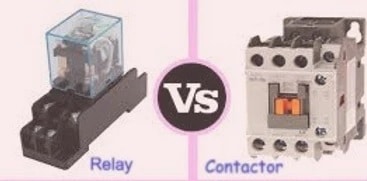In this post, we will learn what is the difference between contactor and relay. We use contactor and relay in almost all electrical circuits.
We use Contactors and relays for switching on and switching off the loads. The air is the medium of arc quenching after switching off the relay or contactor, and they are also termed as air break contactor or air break relay.
Similarity between Contactor and Relay
Both contactor and relay function on the electromagnetic induction principle. When current flows through the coil of the contactor or relay, it generates a magnetic field. The magnetic field exerts a force on the actuator which pulls the contacts making NO contacts to close and NC contacts to open. The reverse process takes place when the coil supply is cut off.
Difference between Contactor and Relay
The main difference between contactor and relay is the current rating of contacts. The contactors have the capacity of handling large currents. Whereas, the relay can handle a small current. The major difference between contactor and relay is as given below.
Difference between contactor and Relay-Size of the Device
The contactor is bigger in size because it handles more current. The relay is suitable for handling current up to 16 amperes.

Current Switching Capacity
The relay is suitable for the current switching of 16 amperes. On the other hand, the contactor is suitable for switching off large loads.
Application
The relay is the most suitable for a single-phase control circuit. While the contactor has wide applications in 3 phase power circuits.
System Voltage
Voltage rating
Relay – 250 Volts
Contactor – 1000 Volts
Auxiliary Contacts
The relay has usually 2 NO+ 2NC contacts, up to 6 NO+ 6 NC is also possible. The current rating of all the contacts is equal. A contactor has three or 4 power contacts designed to carry a large current. The contactor has auxiliary contacts of lower current rating used in the control circuit.
Difference between contactor and Relay –Spring Loaded Contacts
The relay is used to handle lower current, therefore the relay does not have spring-loaded contacts. On the other hand, the contactor handles a large current therefore the contacts are designed with spring-loaded features. This ensures switching off contactor during coil de-energization. The spring-loaded contacts help in preventing the contact from bouncing as well, and hence the life of the contactor enhances.
Arc Suppression System
The contactor has an arc suppression system that quickly suppresses the arc at the instant of switching off. The arc forms during switching off contactor. Therefore, we use contactor to handle the large current. Whereas we use a relay to handle lower current hence relays do not need arc suppression
Read Next: